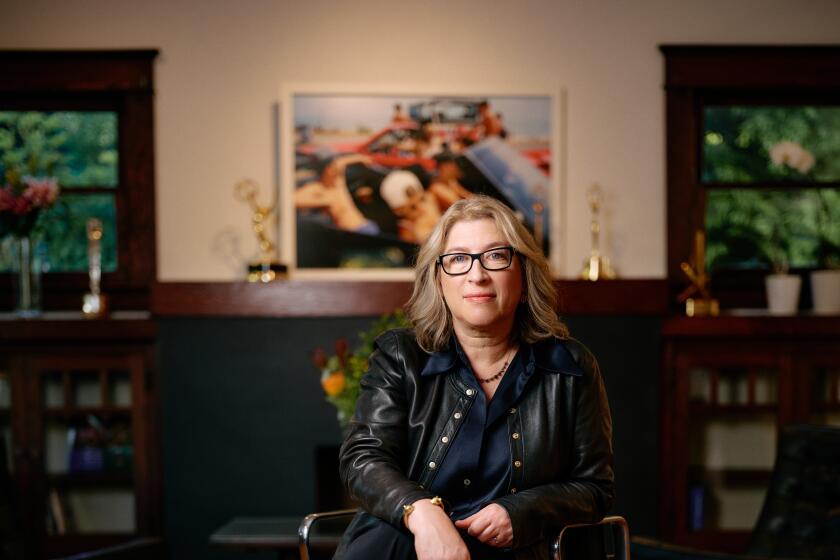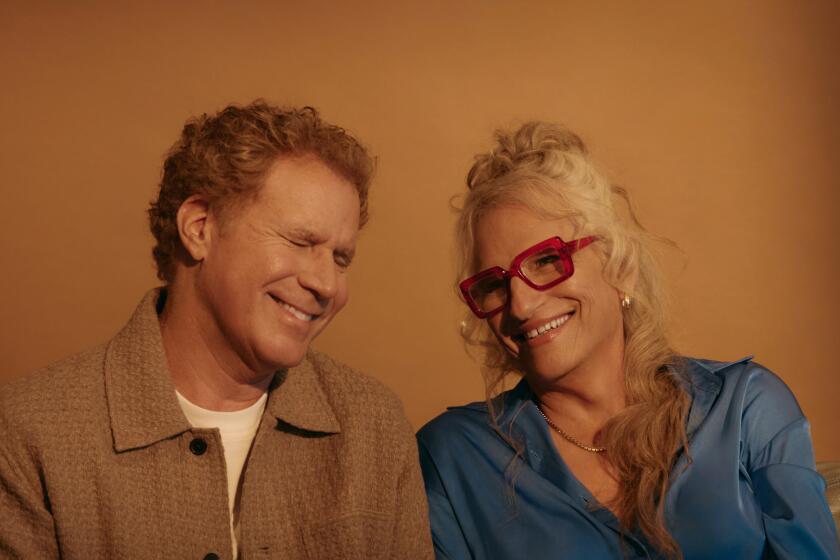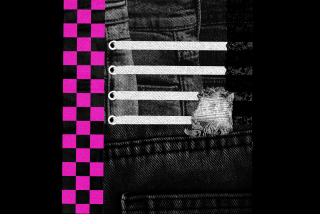Column: The disturbing new after-school special that parents of teenagers need to see

- Share via
My 17-year-old daughter occasionally reminds me that if I had been more supportive of her early success on Musical.ly, she might be a TikTok star by now and I could retire. Presumably to be her manager.
I regret nothing.
Certainly not after watching the FX docuseries “Social Studies.” As schools reopened after the COVID-19 closures, filmmaker Lauren Greenfield set out to explore the impact of social media on the first generation of “digital natives.”
Over the course of a school year, she spoke with and filmed a group of students from (mostly Westside) Los Angeles high schools who opened their screens to her in hopes of discovering what late adolescence is like for those who’ve grown up with smartphones in their hands.
For many of them, the answer is: Not great. In part because of social media.
Girls and young women are encouraged to post provocative images and then shamed or abused for doing so. Rumors and feuds are amplified to a toxic degree. Mental illness, including anorexia, is often fetishized. Young people are led to believe that their worth is determined by the number of likes/positive comments their posts receive. Racism, sexism, classism and LGBTQ+ hate abound; predatory adults lurk, as does misogynistic and violent porn. And an ill-considered or malignant post can have lasting effect.
Even those who do not directly experience the shaming, physical threats, hate speech or predators are hyper-aware of them, just as they are aware of the widening gulf between their lives and the highly curated version to which they regularly compare themselves, often resulting in anxiety, depression and other emotional disorders.
Several of my friends who have preteen kids have told me they’re too scared to watch the series, which critics have invariably referred to as shocking and disturbing. Having raised three teenagers, all of whom had smartphones in high school, I found nothing shocking in “Social Studies.”
Lauren Greenfield’s latest project, “Social Studies,” is a five-part docuseries that looks at teen social media use and its effects. It premieres Friday at Telluride and comes to FX on Sept. 27.
Disturbing, yes; shocking, no.
It did prompt a chat with that 17-year-old about choking and BDSM (“Oh my God, Mom, not the porn talk again,” she said, before fleeing to her room), but anyone who has been paying attention to tales from and studies of teens active on social media knows two things.
One, a few kids can get very rich. And two, many more fall victim to a world that they cannot control.
But if I wasn’t shocked by what I saw in “Social Studies,” I was at times sad and at others outraged. Not just by some of the things that happen to the project’s participants over the course of a school year (and their apparent belief that no adult can or will come to their aid), but by the fact that Greenfield’s work, although occasionally messy, is legitimately groundbreaking.
We know that high school can be a dystopian nightmare for some kids. We know that social media can make the situation worse. So why has it taken this long for someone to make a docuseries of this depth and quality about it?
Watching it, I longed for the days of the after-school special, when broadcast networks at least attempted to address issues affecting children and teens in a nonjudgmental way that also drew attention to reality.
God knows we have spent decades leveraging the hellscape that is high school 18 ways to Sunday for fun and profit. From “A Separate Peace” to “Mean Girls: The Musical,” that teetering cusp between childhood and adulthood has fueled more modern literature, music, art, film and television than any four-year period save, perhaps, the world wars.
But we tend to like high-school tales told by adults looking back through a prism of time, maturity and/or nostalgia. Meanwhile, contemporary teens are invariably branded with some form of problem. Members of the baby boom generation have been spluttering about “those damn kids” for years — even as they wipe their eyes after watching “Rebel Without a Cause” for the 157th time.
These days, the most ubiquitous complaint is “those damn kids” never look up from their phones. By filming teenagers in the wild, Greenfield at least attempts to discover why that is.
Not surprisingly, a number of the dozen or so young people who participated in “Social Studies” feel pressured to fit into restrictive molds of beauty, success and popularity; most feel the need to be seen and validated by their friends. In other words, high school. But at light speed, with a mass audience and a permanent record.
Late adolescence has always been about leading two separate lives — the one you show the adults in your life and the one you live with your friends. Interpersonal drama is a given and mistakes are often made. Now, though, those “lives” are carefully curated visions that bear little resemblance to reality, those “friends” can include thousands of strangers (some of them adults), and that drama plays out not in rumor or whispers but in an avalanche of vitriolic commentary.
There is also friendship and fun, news and silly videos. But virtually all of the students prominently featured in “Social Studies” have a love/hate relationship with the platforms on which they regularly post.
Well, more than that. Many voice the belief that the digital world has a deleterious effect on their lives while at the same time admitting they cannot imagine abandoning it.
It seems important to mention here, though it is not discussed in the series, that the people who built and maintain these platforms make their money by designing them to feel indispensable. The painful dilemma many of these young people express is part of a deliberate business model.
Many of the events that occur in “Social Studies” — an unexpected pregnancy, an out-of-control party that includes an overdose, a family divided by transphobia, a young woman ditching her friends for her boyfriend, a sexual assault — could just have easily taken place in a time before MySpace, much less Instagram (though a young man’s online vigilante justice against teen predators is distinctly digital). Nor did social media invent racism, sexism, homo- and transphobia, bullying or body-shaming. Plus, there are many outlets on the very same platforms for support, solace and community that may be absent in teens’ home or school lives.
But the unregulated nature of these platforms leverages and exacerbates some of the worst aspects of adolescence. Social media thrives on its ability to explore the confluence of distance and intimacy, allowing users to write things they might not ever say in person, never mind to a crowd, and post it to a thousand followers. These widely circulated comments are often received in isolation, to be interpreted without context and brooded over in silence.
All of this is, or should be, common knowledge as well. California recently passed a law requiring schools to limit or ban cellphone use in part because, according to the bill, it “promotes cyberbullying, and contributes to an increase in teenage anxiety, depression, and suicide.”
With ‘Will & Harper,’ the ‘SNL’ star and his friend Harper Steele face a new twist on an old challenge in LGBTQ+ representation: How to educate cis viewers without alienating trans ones.
But it’s one thing to read about, or even legislate against, the negative effects of teen social media use; it’s another to see it occur on the actual screens to which Greenfield was granted access or to watch these still very young people fold into themselves as it happens.
There is a “scared straight” aspect to “Social Studies,” which seems to be aimed at parents who may not know what their children are doing while hunched over their phones, who have somehow avoided all of the recent research about the impact of digital dependence on young people.
But the 22 million Americans ages 15 to 19 exist in the wider world as well — as students, employees, neighbors and cultural arbiters. Generational experiences are never just a familial issue.
So what are we supposed to do? Restricting phone use during school hours may remove a source of classroom distraction — kids might have to resort to passing notes! — but it doesn’t solve the “problem” of social media. The platforms should certainly be more strictly regulated, but since they have not shown much interest in, say, protecting users from Russian election interference, I’m not holding my breath waiting for them to moderate teen hate speech.
Cyberbullying is, and should be, taken seriously at many schools, but that only works if kids report it. Parents can restrict access to certain apps, limit phone usage to certain times of the day and/or monitor usage, but that can also backfire by dampening a child’s desire to share when something upsetting or potentially dangerous happens to them online.
So perhaps the best thing we can do is talk about it. And if “Social Studies” falls far short of being a definitive or broadly representative look at the issue — far too many of the kids are applying to Yale, for one thing — as a conversation-starter, like those after-school specials of yore, it is very effective.
These things are happening, not to every kid but to many of them. And those who think the docuseries might be too shocking or horrifying for their taste are squarely its target audience.
If you have kids in your life, “Social Studies” will undoubtedly prompt an important conversation or two. And if you don’t, well, one way or another, everyone is affected by teen culture — and trying to understand it might be more helpful than dismissing “those damn kids” and their phones.
More to Read
The complete guide to home viewing
Get Screen Gab for everything about the TV shows and streaming movies everyone’s talking about.
You may occasionally receive promotional content from the Los Angeles Times.









